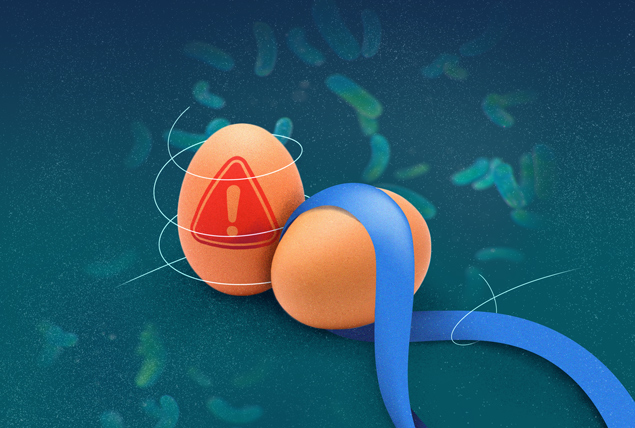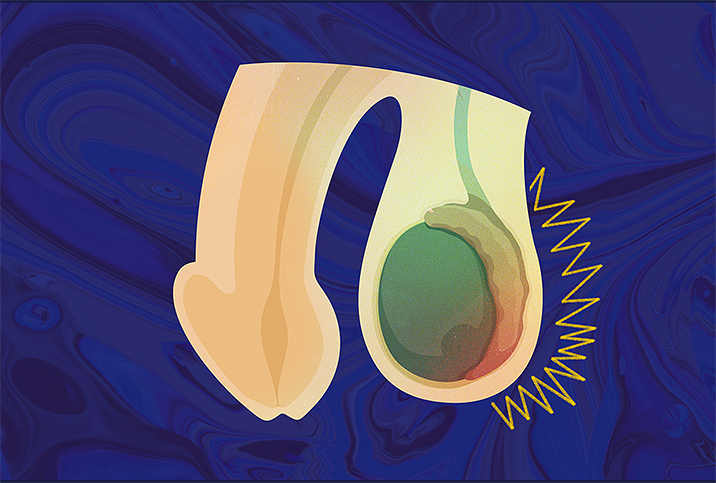What Are the Causes and Symptoms of Epididymitis?

Epididymitis is a condition that can affect the male genitalia. The epididymis, a coiled tube at the upper back side of the testicle, becomes inflamed. To explain the condition, we should start by reviewing what the epididymis is and outlining its function.
One of the primary purposes of the male reproductive system is to produce sperm, the man's method of contributing his DNA to human reproduction. Long before sperm is ejaculated from the penis and embarks on its journey to seek a female's egg (or ovum) to fertilize, the sperm cells must develop and mature.
That's where the epididymis comes in.
What is the epididymis?
"The epididymis is a structure above the testicle," said Petar Bajic, M.D., a urologist with Cleveland Clinic. "It's basically a series of very small tubules where the sperm pass on their way from the testicle to the vas deferens—the structure we cut when we do a vasectomy. And the presence of infection or inflammation is called epididymitis."
The epididymis is a tightly-coiled tube about 20 to 23 feet long where immature sperm cells—also called spermatozoa—travel after they're produced in the testicles. They move into the head of the epididymis through ducts located near the top and back of the testicle to begin the process of maturation.
At this point, the sperm can't "swim" on their own, but over the course of about 14 days, the sperm move along the tube until they are ready to be expelled via the vas deferens. (That's another long, muscular tubular structure attached to the tail of the epididymis near the bottom of the testicle.)
The vas deferens carries the mature sperm into the pelvic cavity where it joins with the urethra via a structure called the ejaculatory duct to mix with the rest of the man's semen when he ejaculates.
Epididymitis, the inflammation and/or infection of these tubes, affects about 600,000 men annually, most of whom are between the ages of 14 and 35.
What are the causes of epididymitis?
Epididymitis can be caused by a number of underlying issues, but it's often caused by a bacterial infection. Most frequently, these infections turn out to be E. coli, according to Cleveland Clinic.
For younger men who are sexually active and present with epididymitis, the underlying cause is frequently a sexually transmitted infection (STI). Other bacteria can also be responsible for epididymitis, such as mycoplasma and chlamydia, diseases that men contract via STIs. Other infections, such as the mumps virus and tuberculosis, can cause epididymitis.
"There can be several different causes of epididymitis," Bajic said. "The most likely cause depends on one's age and other risk factors. Which cause is most common depends on their age group. For younger men and boys who experience this, it might actually happen due to a backing up of urine."
That type of epididymitis occurs when urine flows backward into the epididymis due to heavy lifting or other forms of strenuous physical activity. For older men who are experiencing prostate issues, such as enlargement of the prostate or inflammation that affects their ability to urinate normally, urine backing up into the epididymis can carry bacteria with it and cause infection.
"Obviously, these rules do not apply 100 percent of the time," Bajic said. "But when we talk about what are the most common causes, depending on the age, that's generally the cause."
Other causes of epididymitis include the following:
- Urethral blockage
- Prostate issues, such as enlarged prostate or prostate infections
- Having recently used a catheter
- Prostate surgery or surgery on the urethra or bladder
- Trauma to the groin
While epididymitis can be the result of sexual activity, the condition itself isn't classified as an STI. It's a symptom of various STIs and sexually transmitted diseases (STDs), including chlamydia and gonorrhea.
As previously noted, epididymitis isn't always caused by sexual contact. It can develop as a result of prostate or urinary tract infections.
What are the symptoms of epididymitis?
The symptoms of epididymitis are typically centered around discomfort and irritation in the scrotum, but which may radiate out to the rest of the groin. It might start with pain in the scrotum, and you may notice redness and swelling in the testicles. Other symptoms may include the following:
- Sensitivity in the testicles
- Abdominal or pelvic pain
- Urinary urgency
- Discharge from the penis
- Pain when ejaculating
- Heaviness in the testicles
- Blood in the semen
- Chills and fever
- Painful urination (dysuria)
How is epididymitis diagnosed?
Diagnosing epididymitis usually starts with a health history and a physical exam. You may be asked about the following symptoms or experiences:
- Any symptoms and how long you've had them
- Whether the symptoms have changed over time or gotten worse
- Whether you've had unprotected sex recently
- Whether you've had unprotected penetrative anal sex as the active partner
- If you've had recent surgery on your bladder, urethra or prostate
- If you've had a catheter inserted recently
Your healthcare provider will also perform a physical examination of the scrotum, checking for any tenderness, redness or swelling, and they'll likely order a urinalysis to check for bacteria.
Depending on the patient's age and the appearance of the testicles, the provider may also order an ultrasound to confirm that it isn't testicular torsion, an emergency condition that requires immediate surgical repair.
Conclusions
Epididymitis is a relatively common condition that's easily treatable—as long as you get evaluated promptly. It usually only takes a week or two of antibiotics to clear up any underlying bacterial infection.
Treatment will be addressed at length in a subsequent story, but know that you can address the symptoms. Ice the area, elevate the scrotum, drink lots of fluids to help your body clear the bacteria and take NSAIDs such as ibuprofen for pain. These measures will usually see you through with minimal discomfort.
If you suspect you have any of the aforementioned symptoms, schedule an appointment to be evaluated for epididymitis. While it is easy to treat and generally not a terribly serious condition, it can develop serious complications if left untreated.














